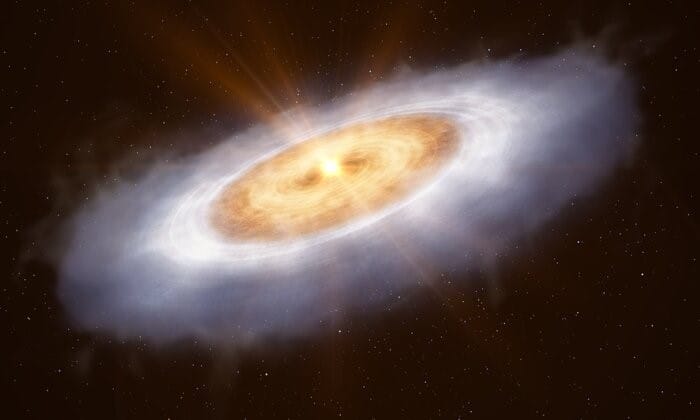
A study of a young star and its protoplanetary disc has provided important insights into the origins of the water on Earth. Researchers have determined the isotopic make up of the water in the disc and found it to be similar to that of comets in the solar system. This suggests that much of the water on Earth has interstellar origins that predate the Sun.
Planetary scientists have long debated the origins of water on Earth. This is because it is generally accepted that the region of the Sun’s protoplanetary disc in which Earth formed was too warm for liquid water to condense along with other materials that make up the Earth. A leading explanation is that Earth’s arrived later on comets and other objects from the outer solar system – after first forming in interstellar space.
Now, a study described in a paper in Nature presents new evidence about the origins of water on Earth based on the observation of young star and its protoplanetary disc. This is a disc of dense gas and dust that forms around a new star and, under the right conditions, will evolve into a system of planets. The study backs up the idea that at least some of the water on Earth arrived from outer regions of the solar system.
Filling a gap
Using the Atacama Large Millimeter/submillimeter Array (ALMA) radio telescope, the authors discovered gaseous water in a planet-forming (protoplanetary) disc surrounding the distant protostar V883 Orionis. The observations fill an important gap in our understanding of the distribution of water during the formation of planetary systems and could mean that the water on Earth predates the formation of the Sun.
John Tobin, an astronomer at the National Radio Astronomy Observatory and lead author of the paper, told Physic World that the crux of this research was the observed ratio of semiheavy water to light water in the V883 Orionis. A light water molecule contains two hydrogen-1 nuclei, whereas semiheavy water contains one hydrogen-1 nucleus and one hydrogen-2 (deuterium) nucleus.
“A portion of the water in your shower is made with deuterium, roughly 1 out of every 3000 molecules,” says Tobin. “This is a large amount because if the water did not form in the interstellar medium, prior to the formation of the Sun, then we’d only expect 1 out of every 50,000 water molecules to be made with deuterium. This tells us that a significant fraction of Earth’s water was formed in interstellar space.”
Important ratio
This isotopic ratio between semiheavy water and light water is the key to understanding how Earth’s water got here. Scientists have measured this ratio on Earth, in comets, in protostars, and even in interstellar space. This observation of V883 Orionis, however, is the first time the ratio has been measured in a protoplanetary disc.
Tobin says that there are two ways that water could arrive on a planet like Earth. These are chemical inheritance and chemical reset. In the chemical inheritance model, water is formed in interstellar space before being delivered to a protoplanetary disc with its isotopic ratio unchanged. Under the chemical reset model, the heat generated within a protoplanetary disc breaks up water molecules. As the disc cools, water molecules reform with a distinct isotopic ratio – which is lower than the ratio expected for water inherited from interstellar space.
It turns out that the ratio of Earth’s water is somewhere between that predicted by these two models. As a result, Tobin and colleagues were keen to study the isotopic ratio of water in a protoplanetary disc, which would shed light on the link that carried water from interstellar space to Earth.
Liquid, not frozen
Using the ALMA radio telescope in northern Chile, Tobin and his colleagues observed the protoplanetary disc around V883 Orionis. This is a protostar – a very young star that is still accumulating materials from its surroundings – that is about 1300 light–years from Earth. This star is about 200 times brighter than the Sun. This extra energy output means that the water in the protoplanetary disc is in liquid form. This is important because it is much easier to measure the isotopic ratio of liquid water than the frozen water in previously observed protoplanetary discs.

Asteroids, not comets, gave Earth most of its water
In 2021, ALMA observed V883 Orionis for six hours, allowing the researchers to determine the isotopic ratio of its protoplanetary disc. They found the ratio to be very similar to that of comets and younger protostar systems.
Tobin explains that this fills in an important gap of our knowledge of the formation of water.
“The ratio of semiheavy to normal water [D/H] in systems like comets, protostars, and Earth indicates that the water has a significant enhancement of its D/H ratio relative to the cosmic D/H ratio,” says Tobin. “Water can only form with a high D/H ratio on the surfaces of dust grains in the cold interstellar medium. Therefore, the fact that the water D/H ratio is enhanced and relatively constant throughout star and planet formation (and Earth) means that a significant fraction of our water must have formed in the cold interstellar medium and been transported to Earth relatively unaltered.”
The research is described in Nature.
